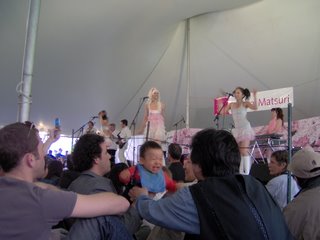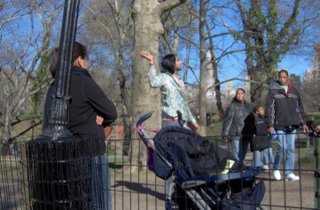Each island we visited was a new, alien landscape - a different world, unlike the others we had visited before. One island would be lush, green, and misty (that's where we saw the giant tortoises), while another would have ashy gray soil with low scrubby "trees" that gave no cover to the blue-footed boobies. On another, the light-colored rocks were covered with red lichen. Naturally, the fauna varied as well. On one island, there were bold marine lizards on the dark rocks. On another, standing on the sandy beach, we noticed that the shallow waters were peppered with large black lumps -- those proved to be turtles mating. In another place, my brother and I went swimming with a sea lion (it joined us in somersaults) and near some large turtles (they were more aloof), and then I inadvertently swam off by myself among a coven of sharks. We saw penguins as well, but they kept their distance.
I'm no longer sure which of these particular photos (if any) were taken by me, rather than my parents. (I'm pretty sure they brought more film than I did, in any event, so the odds are in their favor.) To the extent that I can use the pictures to illustrate something
similar to my diary entries, I'll do so -- without worrying about whether the pictures are from the right island, in proper chronological order, etc. Let my biographers make of it what they will.

12/27/96 - Afternoon on
North Seymour Island. As we approached the island, there were
sea lions everywhere: on the rocks, in the water, on the coarse tan sand. We came up well to the side of them, but there were still many near us. Red-legged, blue-bodied
"sally lightfoot" crabs scuttled out of our way. Light gray
lizards watched us. One of the sea lions was much scrawnier than the others, and the pup's fur was a little more oily and matted than the others as well. It has apparently been rejected by its mother and (gulp) will die soon. Apparently, neglected pups will sometimes get so thirsty that they drink sea water and die - not sure if that is any faster or less painful than starvation. The sand in this area is red like sandstone. The
palo santo (holy tree?) has a pungent, minty smell - or like turpentine, to some. No leaves, just silvery-gray branches, twisting out. Succulent cacti (prickly pear type).
Blue footed boobies - the females are larger than the males and seem to have bigger pupils, although our resident naturalist informs us that it is just extra pigment. They have a light blue-gray or slate blue beak, much like weathered slate-blue paint on wood, and almost a dull acqua blue for their webbed feet. It looks like 4 "toes" in the web, and no other toes. When they walk or raise and lower their feet, they look like they are a little unaccustomed to wearing flippers. The female has a harsh trumpeting sound, the male has a sibilant whistling sound. The first pair was very near the path, and like all the other animals we saw today, didn't pay any attention to the visitors.

Frigate birds - with a five-foot wingspan, hooked beak (dark in adults, white like the rest of the head in juveniles) - abounded. The males have the crinkly dark red skin haning around the front of their necks, like a bib. To attract females, the male's pouch swells up like a red rubber balloon. The male is a bit vulnerable at this time - if he is out trying to feed, others may come up and puncture his pouch (and supposedly, drink his blood). The story is that frigate birds live for 70 years, but mate only once every 4 years (and not for life). Supposedly, if a male is unsuccessful in attracting a female, he may try again. According to our guide, sometimes two unsuccessful males will team up, and the dual red, inflated pouches side by side are somehow irresistable to females. Why does this remind me of college fraternities? The guides are trained naturalists, but it is not clear how much of this is fanciful exaggeration or wishful thinking. The young are fuzzy white balls in the nests; apparently they need to stay in the nest for 4 years.
We also saw marine iguanas and yellow-tailed warblers.

We saw sea lion pups nuzzling at their mothers' teats. In one case, the upper two teats were vacant and attracting flies which the mother shooed away with her flippers as the pup alternated between the two lower teats. Flies followed as soon as the pup vacated a teat. Flies swarmed all over the sea lions. I would associate this with disease or infestation, but the sea lions appeared healthy. Some of the sea lions were body surfing -- looked like they were having fun.
The survival of the fittest aspect involved older siblings driving the younger ones away from the mother (so the weak ones will starve and die while the strong ones get stronger). There was one exception, a mother sea lion trying to scare off the older pup and feed the little one. It looked like a losing battle, unless she was actually willing to kill or maim the older one.
The land on this first island was really arid, with low scrubby brushes, abundant nesting frigate birds and blue-footed boobies (mostly pairs, though they don't mate for life), sea lions sprawled all over the beach or the occasional mother-pup pair shuffling off in front of us (neither dawdling nor hastening to avoid us).

12/28 - We moored off the shores of
Batholomew Island, maybe on its western side. Under the bright moon and stars, the land around us rose in dramatic peaks and a sharp pinnacle, as illustrated below.
There are three drawings on this sheet, each showing Bartholemew Island in profile, in successive close-ups. The top one shows a ridge, descending to a beach, with the sharp pinnacle on the right. The other two successively zoom in to the profile of the pinnacle. The text on the deepest zoom explains that a particular portion of the profile "
forms one crescent, like a thumb poised above a remote control."





It would have been helpful to bring on this tour (i) a very warm and waterproof sleeping bag, (ii) a beach towel and (iii) a canteen. We ate and drank foods that did not seem "safe" but supposedly had been "specially treated" so that we wouldn't be sick. No one got sick, fortunately.

My last "family vacation" was to the Galapagos Islands in 1996. I'll share some pictures for now, and add text later.

































